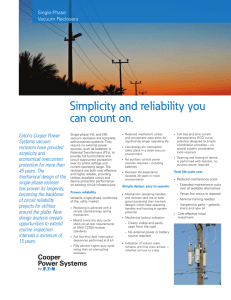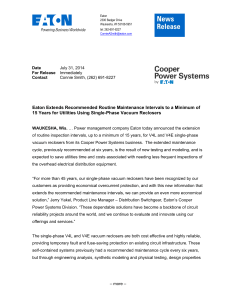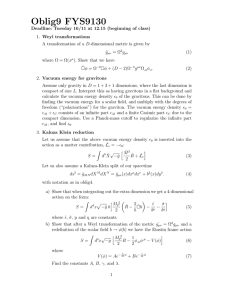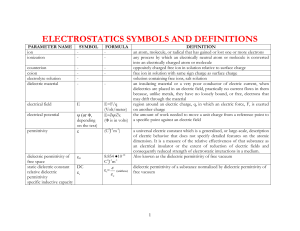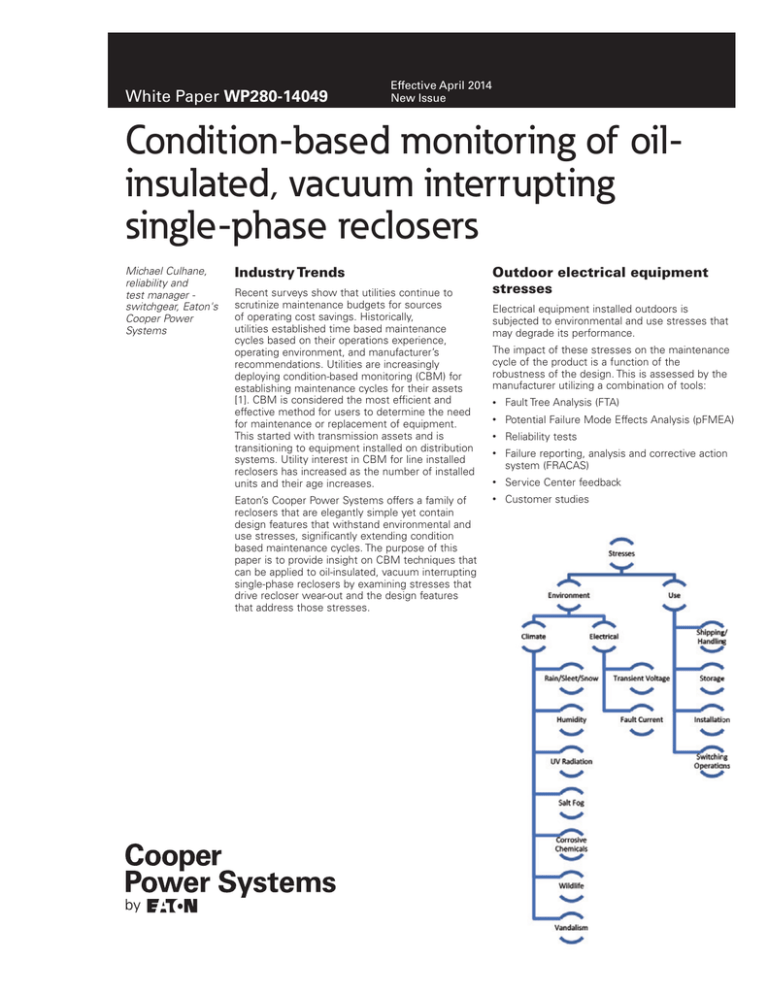
White Paper WP280-14049
Effective April 2014
New Issue
Condition-based monitoring of oilinsulated, vacuum interrupting
single-phase reclosers
Michael Culhane,
reliability and
test manager switchgear, Eaton's
Cooper Power
Systems
Industry Trends
Recent surveys show that utilities continue to
scrutinize maintenance budgets for sources
of operating cost savings. Historically,
utilities established time based maintenance
cycles based on their operations experience,
operating environment, and manufacturer’s
recommendations. Utilities are increasingly
deploying condition-based monitoring (CBM) for
establishing maintenance cycles for their assets
[1]. CBM is considered the most efficient and
effective method for users to determine the need
for maintenance or replacement of equipment.
This started with transmission assets and is
transitioning to equipment installed on distribution
systems. Utility interest in CBM for line installed
reclosers has increased as the number of installed
units and their age increases.
Eaton’s Cooper Power Systems offers a family of
reclosers that are elegantly simple yet contain
design features that withstand environmental and
use stresses, significantly extending condition
based maintenance cycles. The purpose of this
paper is to provide insight on CBM techniques that
can be applied to oil-insulated, vacuum interrupting
single-phase reclosers by examining stresses that
drive recloser wear-out and the design features
that address those stresses.
Outdoor electrical equipment
stresses
Electrical equipment installed outdoors is
subjected to environmental and use stresses that
may degrade its performance.
The impact of these stresses on the maintenance
cycle of the product is a function of the
robustness of the design. This is assessed by the
manufacturer utilizing a combination of tools:
•
Fault Tree Analysis (FTA)
•
Potential Failure Mode Effects Analysis (pFMEA)
•
Reliability tests
•
Failure reporting, analysis and corrective action
system (FRACAS)
•
Service Center feedback
•
Customer studies
Technical Data WP280-14049
Condition-based monitoring of oil-insulated,
vacuum interrupting single-phase reclosers
Effective April 2014
Analysis of this data reveals wear-out modes that fall into two
distinct classifications: Detectable and Non-detectable. Detectable
wear-out modes are those that can be observed by the user as part
of a routine inspection program or through normal interface with the
device. These include:
•
Mechanism wear – Operation counter exceeds 2500 operations
•
Corrosion – Bleeding rust, oil stains on tank
•
Wildlife damage – Nesting materials near bushings
•
Vandalism – Oil stains on tank, gunshot holes
•
Bushing flashover damage – Lightning arrester isolator and
ground strap separated from arrester body
high density paper for the purpose of managing moisture changes
due to the vented tank. A detailed look at the vented air, oil, paper
insulation system reveals how this system works in concert with
dielectric clearances to eliminate risk of dielectric breakdown due to
changes in oil moisture content.
The primary insulation system of these reclosers is mineral oil.
However, the vented head space air and a high density paper liner
play important roles in managing the moisture content of the oil.
This system of air, oil and paper has been intentionally designed
such that changes in relative moisture levels of the oil and air are
compensated by the moisture capacity of the paper. As applied
in the V4L and V4E reclosers, these materials have the following
relative moisture capacity relationship with temperature:
Critical non-detectable wear-out modes are:
•
Insulation system – Degradation of dielectric strength of oil
•
Vacuum interrupter – Degradation of dielectric strength, loss of
contact pressure due to contact erosion
Previous recommendations for monitoring and assessing the
dielectric strength of the oil involved obtaining oil samples at fixed
time intervals. Vacuum interrupter wear-out has historically combined
data from the operations counter with extrapolations based on
interrupter duty testing. A more accurate method of assessing
vacuum interrupter wear is discussed below that builds on previous
techniques and reveals a substantially longer life.
A closer examination of the design of the insulation system of
oil-insulated, vacuum interrupting single-phase reclosers reveals a
system that actively manages water content. This work is discussed
below and includes testing of worse case water accumulation to
verify dielectric integrity.
0
•
Substantial dielectric clearances (to withstand the effects of
deteriorating oil due to arc interruption under oil)
•
Vented tank (to vent gasses generated from arc interruption under
oil)
•
Paper desiccant (to stabilize the relative saturation of the oil
during cool down after lock-out)
Vacuum interrupting design features:
•
Arc interruption occurs in the vacuum bottle – no by-products
contaminate the oil
•
Dielectric clearances of the oil Interrupting design are kept in the
vacuum design – increasing design margin
•
Vented tank from the oil interrupting design is kept in the vacuum
design – minimizing stress on gaskets
•
Paper desiccant from the oil interrupting design is kept in the
vacuum design – stabilizing the relative saturation level of the oil
Eaton’s Cooper Power Systems Types V4L and V4E are mineral oilinsulated, vacuum interrupting reclosers. They share many design
features with the oil-insulated, oil-interrupting L and E reclosers.
Among these is a vented air space above the oil. This is an essential
design feature for the oil-interrupting device because arcs drawn
under oil during current interruption generate gas pressure that must
be equalized. The vented air space allows an exchange with ambient
air. Both oil interrupting and vacuum interrupting designs include
2
www.cooperpower.com
100
T (C)
In a stable environment (constant temperature and moisture) all
materials will seek equilibrium to the same relative saturation point.
As temperature increases, moisture will move from the paper to
the oil and then to the air. In the vented air space system, the moist
head space air will seek equilibrium with the outside ambient air. As
temperature decreases, moisture in the oil will be absorbed by the
paper as the process reverses [2],[3].
Managing the relative saturation level of the oil is important because
the dielectric strength of the oil varies with its relative saturation
level.
Mineral Oil Dielectric Strength [2]
80
Breakdown Voltage (kV)
Oil-interrupting design features:
Oil
Air
(g)
Oil-insulated single-phase reclosers
Oil-insulated single-phase reclosers are an affordable and highly
reliable system protection device. For oil interrupting reclosers (arc
interruption occurs under oil), the maintenance cycle is primarily
driven by the degradation of the oil’s dielectric properties due to
accumulation of carbon and other arc by-products in the oil. The
industry transition to oil-insulated, vacuum interrupting reclosers (arc
interruption occurs in a vacuum bottle) eliminates the by-products
in the oil and significantly reduces the risks associated with oil
degradation.
Paper
Saturation
Water
Content
70
60
50
40
30
20
10
0
0
20
40
60
80
100
120
140
160
180
Water Saturation (%)
The dielectric integrity of the recloser depends on two key design
elements: the moisture management system described above and
adequate dielectric clearances of oil-insulated electrical parts within
the tank.
The next table lists the typical water concentration within the V4L
or V4E for various application scenarios. The first represents factory
level conditions. The second represents storage in a high ambient
Technical Data WP280-14049
Condition-based monitoring of oil-insulated,
vacuum interrupting single-phase reclosers
temperature and relative humidity environment. The last is at rated
load current in a warm ambient environment.
Water Concentration V4L/V4E
(Steady State)
T (C)
Relative Sat.
Level
Air (g)
Oil (g)
Paper (g)
20°
70%
.05
1.3
51
40°
90%
.19
3.7
60
60°
80%
.42
6.7
50
A typical operating scenario may involve a recloser carrying rated
load current, cycling to lock-out in response to a permanent fault,
and then cooling to ambient. In this scenario, the moisture absorbed
while hot will cause the relative moisture level of the oil to increase
dramatically as the recloser cools, resulting in a significant drop
in dielectric strength. The recloser design anticipates this drop in
dielectric strength through increased spacing between energized
parts and ground. This ensures adequate dielectric strength until the
water in the oil can be absorbed by the paper desiccant.
To verify the scenario above, a V4E recloser sample (27 kV, 100
A coil, 2A/2B timing) was deliberately forced into a high relative
saturation scenario and tested. The sample had initial measured
water content in oil of 10 ppm (approximately 0.72 g of water).
Assuming equilibrium between oil and paper, the initial water
content of the paper was calculated to be approximately 13.0 g. To
emulate equilibrium when hot (60 °C, 80%RS) the water content
of the oil would need to be increased to 6.7 g and the paper
water content would need to increase to 50 g. To insure saturation
after cool down, 50 g of water was added to the oil. To promote
absorption the unit was heated and water added in two steps
(before and after heating).
The sample was then cooled to room temperature and subjected
to rated BIL and rated ac withstand testing. Testing was conducted
in the open contact position from both the load and source side
terminals to ensure all current carrying parts were stressed to
ground. The results of the testing demonstrate that the internal
(under oil) dielectric clearances of the V4L and V4E reclosers are
sufficient to withstand rated BIL and ac withstand voltage stresses
after the dielectric strength of the oil has been reduced.
The results of this testing verify that the oil, air, and paper desiccant
system in concert with generous internal conductor spacing
mitigates risks associated with moisture accumulation from water
vapor.
Chemical degradation of the oil (aka, oxidation) poses a significant
concern in transformer applications but the risks are far lower in
switchgear. Oxidation is a function of time and temperature, and the
moderate oil temperature rise in switchgear (typically 30 °C for the
V4L/E at 280 A) results in a slow thermal aging rate. Degradation
may affect many important oil properties (e.g., viscosity, specific
gravity, flash point, total acid number, breakdown voltage, dissipation
factor and volume resistivity). While no industry wide consensus has
been reached on which property defines end-of-life (EoL), they all
agree that the reaction rate is slow at 60 °C [4], [5].
Oil Oxidation
(30 °C Ambient + 30 °C avg Oil Rise = 60 °C)
Oil Property
Volume Resistivity
Loss Factor [4]
Acidity
[5]
[4]
EoL Criteria
EoL
1.5x1011
37.6 yrs
50
38.4 yrs
0.3mg KOH/1g oil
28.5 yrs
Effective April 2014
Contact Wear
Another important consideration in determining the health of the
V4L and V4E recloser is assessing contact wear. With each electrical
operation of a vacuum interrupter, metal from the surfaces of the
contacts is vaporized. The amount of metal is a function of vacuum
interrupter design and the amount of current being interrupted.
The metal vapor condenses on the interior surfaces of the vacuum
interrupter and can eventually degrade dielectric strength. The loss
of metal from the contact surfaces also affects the mechanism
by changing the amount of energy stored in the contact pressure
spring. The V4L and V4E mechanism has been designed to provide
adequate contact pressure with up to 3 mm of contact wear.
Assessing the wear of the vacuum interrupter contacts poses the
challenge of measuring contact erosion and metal vapor deposition
in a sealed vessel. A non-invasive alternative is the use of vacuum
interrupter life test results to estimate the maximum number
of operations for a given series coil current rating. The V4L and
V4E reclosers utilize a VSAM axial magnetic vacuum interrupter.
Numerous interrupter duty test programs have been conducted on
this family of vacuum interrupters since first being introduced in
1988. The data from these programs is used to correlate operations
counter readings to remaining life based on the magnitude and
frequency of faults.
Eaton’s Cooper Power Systems recommends the time integrated
current method which also establishes the contact life of vacuum
interrupters[6]. The time integrated current is calculated based on
contact part at current peak and fault clearing at first current zero
crossing. The number of interruptions at various current levels and
the cumulative integrated currents are:
Test Current as a
Percent of Rated
Interrupting
Current
8 kA Interrupter
Duty*
12.5 kA
Accelerated
Interrupter
Duty*
24 kA
Accelerated
Synthetic
Circuit
Interrupter
Duty
20%
88
88
80
33%
0
101
81
50%
112
81
106
67%
0
16
83
83%
0
0
85
100%
32
36
88
Cumulative
Integrated Current
(kAs)
2.37
6.5
54.5
* Extensive fault testing meets twice half life of vacuum interrupter as defined by IEEE Std C37.60™1981 standard. Following this testing, all samples passed post duty electrical testing.
It is important to note that due to test lab availability and time, none
of these tests resulted in contact end of life. All samples passed
post duty electrical testing. Even so, the data is sufficient for the
user to calculate the number of operations to estimated end of life
based on fault current magnitude scenarios.
Faults occurring on overhead power systems protected by reclosers
have fault impedances that vary by the conductivity and nature of
the fault. The criteria for contact life, including the distribution of
the number of faults and their current levels, was established by
the working group members of IEEE Std C37.60™-1981 standard.
Presumably these criteria represent the operating practices of
the utilities that reference the industry standard in their product
specifications. Cumulating integrated current for each test level from
IEEE Std C37.60™-1981 standard Table 6 and converting to per unit
basis results in the graph on page 4.
This near normal statistical distribution is reasonable for reclosers
installed at locations where available fault current is at or near nameplate
rating. This information can be consolidated into use scenarios that allow
the user to determine contact life by monitoring the operations counter
for the scenario most appropriate to the application.
www.cooperpower.com
3
Technical Data WP280-14049
Condition-based monitoring of oil-insulated,
vacuum interrupting single-phase reclosers
Effective April 2014
Conclusions
Full Duty Fault Current Distribution
•
Condition based monitoring techniques can be successfully
applied to oil-insulated, vacuum interrupting reclosers through
routine visual inspection of installed product.
•
Eaton’s Cooper Power Systems V4L and V4E vacuum interrupting,
hydraulically controlled reclosers time proven and simplistic
design eliminates wear-out failure modes found in more complex
designs.
•
These designs share tanks, mechanisms, insulation systems and
design clearances with their oil interrupting forefathers providing
additional design margin and robustness.
•
Scenario 1 is most conservative. It utilizes the cumulative integrated
current from the 8 kA duty testing and assumes all operations are at
the maximum rated fault current of the device.
The combination of oil, paper desiccant, and free breathing
tank actively manages moisture content of the oil over the
recloser operating life. This analysis confirms anecdotal evidence
presented by customers that maintenance cycles can be
extended beyond previous recommendations.
•
Scenario 2 utilizes the cumulative integrated current from the 8 kA
duty testing and assumes that fault magnitudes and frequencies are
distributed similar to those from the duty tests specified in IEEE Std
C37.60™-1981 standard.
Operation counts combined with a user selected application
scenario provides an easy to use method for determining the
maintenance intervals for these reclosers.
•
The robust VSAM vacuum interrupter’s duty cycle extends beyond
the mechanism wear for numerous application scenarios.
•
Maintenance cycles can be extended to a minimum of fifteen
years (e.g. 100A coil: 40 ops/year x 15 years= 600 operations).
PU Integrated Current
0.600
0.500
0.400
0.300
0.200
0.100
0.000
20%
50%
100%
Fault Current as % of Interrupting Rating
Scenario 3 utilizes the cumulative integrated current from the
12.5 kA accelerated duty testing and assumes that fault magnitudes
and frequencies are distributed similar to those from the duty tests
specified in IEEE Std C37.60™-1981 standard.
Scenario 4 utilizes one fourth the cumulative integrated current from
the 24 kA accelerated synthetic duty testing (a value selected based
on other studies that correlate the synthetic test results to power
test results ) and assumes that fault magnitudes and frequencies are
distributed similar to those from the duty tests specified in IEEE Std
C37.60™-1981 standard.
Maximum Number of Operations
Coil
Rating
Max
Interrupting
Scenario
1
Scenario
2
Scenario
3
Scenario
4
15
.9kA
685
1533
25001
25001
25
1.5kA
411
920
25001
25001
35
2.1kA
293
661
1813
25001
50
3.0kA
206
459
1260
25001
70
4.2kA
147
327
898
1796
100 280
6.0kA
103
232
629
1259
1) Vacuum interrupter life is constrained to mechanism life of 2500 operations
Biography
Michael P. Culhane, reliability and test manager for switchgear
products at Eaton’s Cooper Power Systems, has been with the
company for 30 years. During this time he has held various roles
spanning application engineering, custom products engineering,
product development, project and program management and
product reliability. Michael has a BS in Electrical Engineering from
Marquette University and is a member of IEEE PES, a PMI certified
Program Management Professional, and a licensed Professional
Engineer in the state of Wisconsin.
References
[1] R. Bush, “Maximizing Our Aging Transmission and Distribution
Assets”, Transmission and Distribution World, November 18,
2013.
[2] A. Pondes, E. de Meulemeester, et al, “Water Absorption by
Oil in MV Switchgear”, 20th CIRED International Conference on
Electricity Distribution, June 2009.
[3] Y. Du, M. Zahn, B.C. Lesieutre, A.V. Mamishev, “Moisture
Equilibrium in Transformer Paper-Oil Systems”, IEEE Electrical
Insulation Magazine, January/February 1999, Fig 10.
[4] L.V. Badicu, L.M. Dumitran, P.V. Notingher, R. Setnescu, T.
Setnescu, “Mineral Oil Lifetime Estimation Using Activiation
Energy”, 2011 IEEE International Conference on Dielectric
Liquids.
[5] M.R. Meshkatoddini, S. Abbospour, “Aging Study and Lifetime
Estimation of Transformer Mineral Oil”, American Journal of
Engineering and Applied Sciences, 2008, pp 384-388.
Eaton
1000 Eaton Boulevard
Cleveland, OH 44122
United States
Eaton.com
Eaton’s Cooper Power Systems Business
2300 Badger Drive
Waukesha, WI 53188
United States
Cooperpower.com
© 2014 Eaton
All Rights Reserved
Printed in USA
Publication No. WP280-14049
[6] P.N. Stoving, J.F. Baranowski, “Interruption Life of Vacuum
Circuit Breakers”, Proceedings IEEE 19th International
Symposium on Dischares and Electrical Insulation in Vacuum,
Xi’an China, 2000, pp. 388-391.
Eaton and Cooper Power Systems are valuable
trademarks of Eaton in the U.S. and other
countries. You are not permitted to use the
these trademarks without the prior written
consent of Eaton.
IEEE Std C37.60™-1981 standard is a
trademark of the Institute of Electrical and
Electronics Engineers, Inc., (IEEE). This
publication is not endorsed or approved by
the IEEE.
For Eaton's Cooper Power
Systems vacuum interrupting
single-phase product
information call
1-877-277-4636 or
visit: www.cooperpower.com.

